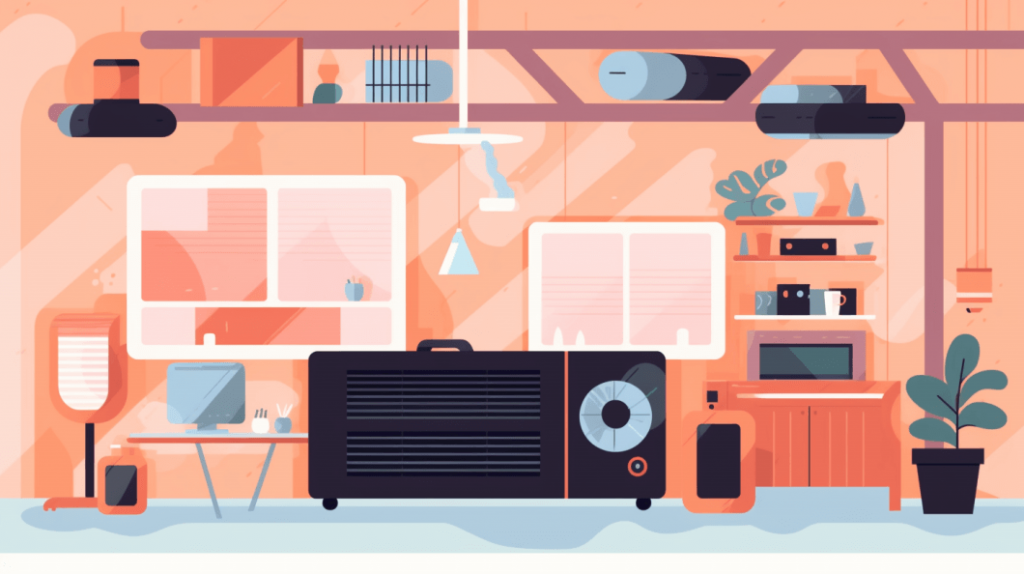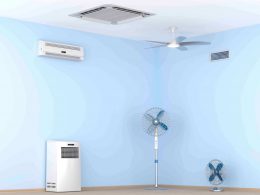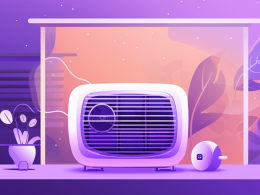Portable air conditioners have become increasingly popular due to their affordability, energy efficiency, and the ease with which they can be installed and moved. As more and more people choose these convenient cooling solutions for their homes and offices, it’s essential to understand the importance of regular maintenance and timely repairs to ensure their long-lasting performance.
In this ultimate guide to portable air conditioner repair, we’ll explore common issues, share troubleshooting tips, and walk you through some DIY solutions that can help you keep your unit in top shape. We’ll also discuss when to call a professional and how to choose the right repair service for your needs.
By being proactive about addressing problems and maintaining your portable air conditioner, you can enjoy a comfortable and cool space for years to come.
Common Issues with Portable Air Conditioners
Portable air conditioners, like any appliance, can develop issues over time. Being familiar with the common problems associated with these units can help you identify and resolve them quickly. Here are some typical issues that you may encounter:
Leaking water
One of the most common problems with portable air conditioners is water leakage. This can be caused by a full condensate reservoir, a clogged drainage line, or improper installation. Identifying the source of the leak is crucial for fixing the issue and preventing potential damage to your home.
Not cooling effectively
If your portable air conditioner isn’t providing the cooling performance you expect, there could be several causes, such as dirty filters, blocked air vents, low refrigerant levels, or issues with the evaporator or condenser coils. Regular maintenance and timely repairs can help improve the cooling efficiency of your unit.
Strange noises
Odd noises coming from your portable air conditioner can be a sign of loose or damaged parts. These could include fan blades, motor bearings, or internal components. Identifying the source of the noise can help you determine the best course of action for repair.
Unit not turning on
If your portable air conditioner refuses to turn on, it could be due to a tripped circuit breaker, a blown fuse, or a malfunctioning power cord. In some cases, the issue could also stem from a faulty thermostat or control board.
Malfunctioning thermostat
A thermostat that’s not functioning correctly can cause your portable air conditioner to cycle on and off too frequently or not maintain the desired temperature. This could be due to an improperly placed temperature sensor, a thermostat calibration issue, or a malfunctioning thermostat that needs replacement.
Being aware of these common issues can help you quickly identify and address problems with your portable air conditioner, ensuring that your unit continues to provide optimal cooling performance.
Basic Troubleshooting Tips
Before diving into portable air conditioner repair, it’s essential to perform some basic troubleshooting to help you pinpoint the issue. Here are a few simple tips to get started:
Ensure proper installation
Improper installation can lead to various problems, such as water leakage or inefficient cooling. Make sure your portable air conditioner is installed according to the manufacturer’s instructions, ensuring that it is level, the exhaust hose is correctly attached, and there is adequate clearance around the unit for proper airflow.
Clean and replace filters regularly
Dirty or clogged filters can significantly affect your portable air conditioner’s performance. Inspect the filters regularly and clean or replace them as needed to maintain optimal airflow and cooling efficiency.
Inspect exhaust hose and air vents
Blocked exhaust hoses or air vents can lead to reduced cooling capacity and overheating. Regularly check these components for any obstructions or debris and clean them as necessary.
Check electrical connections
Ensure that your portable air conditioner is plugged into a grounded outlet and that the power cord is in good condition. If your unit isn’t turning on or seems to be losing power intermittently, inspect the circuit breaker or fuse box to rule out any electrical issues.
Consult the owner’s manual
The owner’s manual for your specific portable air conditioner model is an invaluable resource when troubleshooting issues. It will contain detailed information on common problems, troubleshooting steps, and recommended maintenance practices.
By following these basic troubleshooting tips, you can often identify and resolve many common portable air conditioner issues without the need for professional assistance. If the problem persists or you’re unsure of how to proceed, it’s always best to consult with a qualified technician.
Portable Air Conditioner Repair: DIY Solutions

In some cases, you may be able to resolve issues with your portable air conditioner through simple DIY solutions. Here are a few fixes for common problems that you can try at home:
Fixing a leaking unit
- Emptying the condensate reservoir: If your unit has a removable condensate reservoir, check to see if it’s full. If so, carefully remove and empty it, then replace it securely to prevent further leaks.
- Unclogging the drainage line: If your portable air conditioner has a continuous drainage option, inspect the drainage line for any clogs or obstructions. Remove any debris and ensure that the line is positioned correctly to allow for proper water flow.
Improving cooling efficiency
- Cleaning the evaporator and condenser coils: Dirty coils can significantly reduce your unit’s cooling efficiency. Gently clean the coils with a soft brush or cloth and a mild detergent solution, then let them dry thoroughly before restarting the unit.
- Recharging the refrigerant: If your portable air conditioner’s cooling capacity has decreased significantly, it may be due to low refrigerant levels. Consult your owner’s manual for instructions on how to check and recharge the refrigerant, or seek professional assistance if you’re unsure.
Resolving strange noises
- Tightening loose parts: Inspect your portable air conditioner for any loose or vibrating components, such as the fan blades or motor mount. Tighten any loose screws or fasteners, and make sure all parts are secure.
- Lubricating fan motor bearings: If you hear a squeaking or grinding noise coming from the fan motor, it may need lubrication. Consult your owner’s manual for instructions on how to lubricate the motor bearings, or seek professional help if necessary.
Troubleshooting power issues
- Resetting the circuit breaker: If your unit isn’t turning on, check the circuit breaker to see if it has tripped. If so, reset the breaker and try turning on the unit again.
- Replacing a blown fuse: If your portable air conditioner still doesn’t turn on after resetting the circuit breaker, the issue could be a blown fuse. Consult your owner’s manual for instructions on how to locate and replace the fuse, or call a professional for assistance.
Calibrating the thermostat
- Adjusting the temperature sensor: If your unit is cycling on and off too frequently or not maintaining the desired temperature, the temperature sensor may be out of position. Gently adjust the sensor so that it’s in the correct location, as specified in your owner’s manual.
- Replacing the thermostat if necessary: If adjusting the temperature sensor doesn’t resolve the issue, the thermostat itself may be malfunctioning. Consult your owner’s manual for instructions on how to replace the thermostat or seek professional help.
While these DIY solutions can address some common portable air conditioner issues, always consult the manual and follow safety precautions. If you’re unsure about any of the steps or the problem persists, don’t hesitate to call a professional for assistance.
When to Call a Professional
Although DIY solutions can help you address some portable air conditioner issues, there are situations when it’s best to call a professional technician for assistance. Here are a few instances when you should consider seeking professional help:
Complex repairs beyond DIY scope
If you’re dealing with a problem that involves complex repairs or disassembling the unit, such as a malfunctioning compressor or a refrigerant leak, it’s best to call a professional. Attempting to fix these issues yourself without the proper knowledge and tools can result in further damage or even create safety hazards.
Routine maintenance and inspections
Even if your portable air conditioner is functioning well, scheduling routine maintenance and inspections with a professional technician can help extend its lifespan and ensure optimal performance. A professional can thoroughly inspect the unit, clean internal components, and detect any potential issues before they become major problems.
Warranty coverage and service agreements
If your portable air conditioner is still under warranty or you have a service agreement with the manufacturer or a repair company, it’s important to call a professional for any repairs or maintenance. Performing DIY repairs on a unit under warranty can void the warranty, and service agreements often require that repairs be performed by authorized technicians.
By knowing when to call a professional, you can ensure that your portable air conditioner receives the proper care and attention it needs to continue providing you with efficient cooling for years to come.
Tips for Choosing a Portable Air Conditioner Repair Service
Selecting the right repair service for your portable air conditioner is crucial to ensure that your unit is fixed promptly and effectively. Here are some tips to help you choose the best repair service for your needs:
Look for licensed and insured technicians
Ensure that the technician or company you choose is licensed and insured to perform portable air conditioner repairs. This can provide peace of mind, knowing that the technician has the necessary training and expertise to handle your unit safely and effectively.
Read customer reviews and testimonials
Research the company’s reputation by reading customer reviews and testimonials online. This can give you insight into the quality of their work and their level of customer service. You can also ask the company for references from previous customers.
Compare pricing and service guarantees
Request quotes from multiple repair services and compare their pricing and the services they offer. Keep in mind that the cheapest option isn’t always the best choice. Look for a company that offers a fair price and backs their work with a service guarantee or warranty.
Ask for referrals from friends and family
One of the most reliable ways to find a reputable portable air conditioner repair service is through word-of-mouth recommendations. Ask friends, family, or neighbors if they have had any positive experiences with a particular repair service, as they may be able to provide valuable insights into the quality of work and customer service.
Maintaining Your Portable Air Conditioner for Optimal Performance
Regular maintenance is key to ensuring that your portable air conditioner continues to function efficiently and provide optimal cooling performance. Here are some essential maintenance tips to help you get the most out of your unit:
Scheduling regular maintenance
Even if your portable air conditioner appears to be working well, it’s crucial to schedule routine maintenance and inspections with a professional technician. This can help identify any potential issues early on, allowing for prompt repairs and preventing more significant problems down the line.
Properly storing the unit during the off-season
If you won’t be using your portable air conditioner for an extended period, such as during the winter months, make sure to store it properly. Clean the unit thoroughly, including the filters and coils, and allow it to dry completely before covering it with a protective cover or storing it in its original packaging. This can help prevent damage, mold, and mildew growth during storage.
Keeping the area around the unit clean and clutter-free
Ensure that the area surrounding your portable air conditioner is clean and free of debris or clutter. This allows for proper airflow and reduces the risk of obstructions that can impact the unit’s performance. Regularly dust and vacuum the area around the unit to prevent dirt and debris from being drawn into the air intake.
Using a surge protector to prevent electrical damage
A power surge can potentially damage your portable air conditioner’s electronic components. To protect your unit, consider plugging it into a surge protector, which can help safeguard your air conditioner from voltage spikes and other electrical issues.
By following these maintenance tips and addressing any issues promptly, you can ensure that your portable air conditioner continues to provide efficient cooling and maintain a comfortable environment in your home or office for years to come.
The Bottom Line
Proper maintenance and timely repairs are essential to ensure the long-lasting performance of your portable air conditioner. In this ultimate guide to portable air conditioner repair, we’ve covered common issues, basic troubleshooting tips, and DIY solutions to help you maintain your unit in top shape. We’ve also discussed when to call a professional and how to choose the right repair service for your needs.
By being proactive about addressing problems, performing regular maintenance, and seeking professional assistance when necessary, you can extend the lifespan of your portable air conditioner and continue to enjoy a comfortable and cool space for years to come. Remember that investing in regular care and attention for your unit will not only enhance its performance but also save you money in the long run by preventing costly repairs or the need for early replacement.










